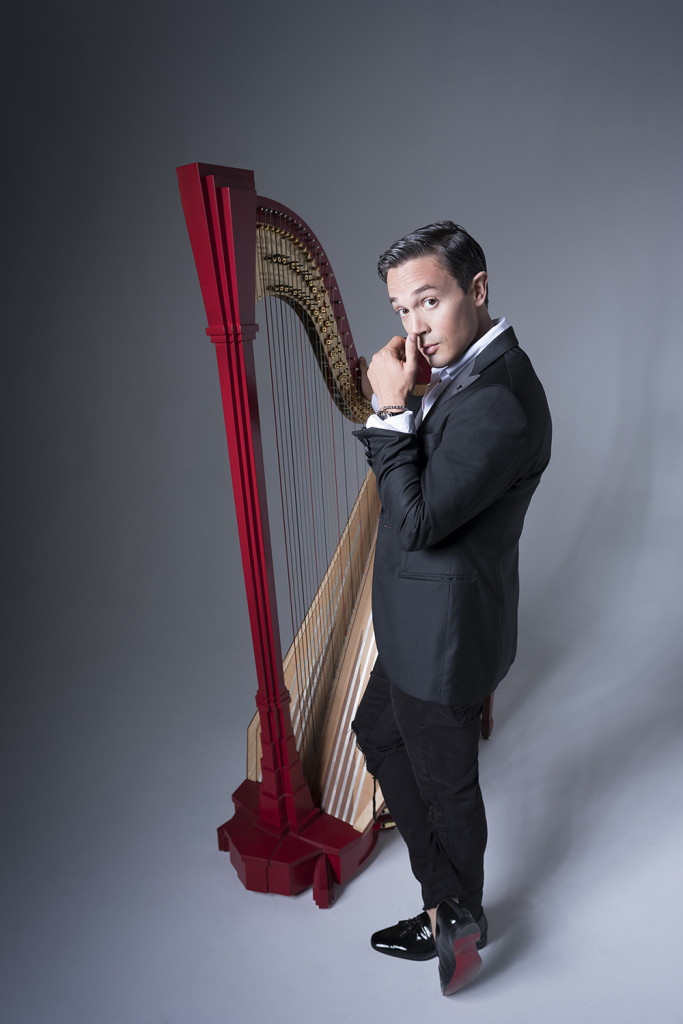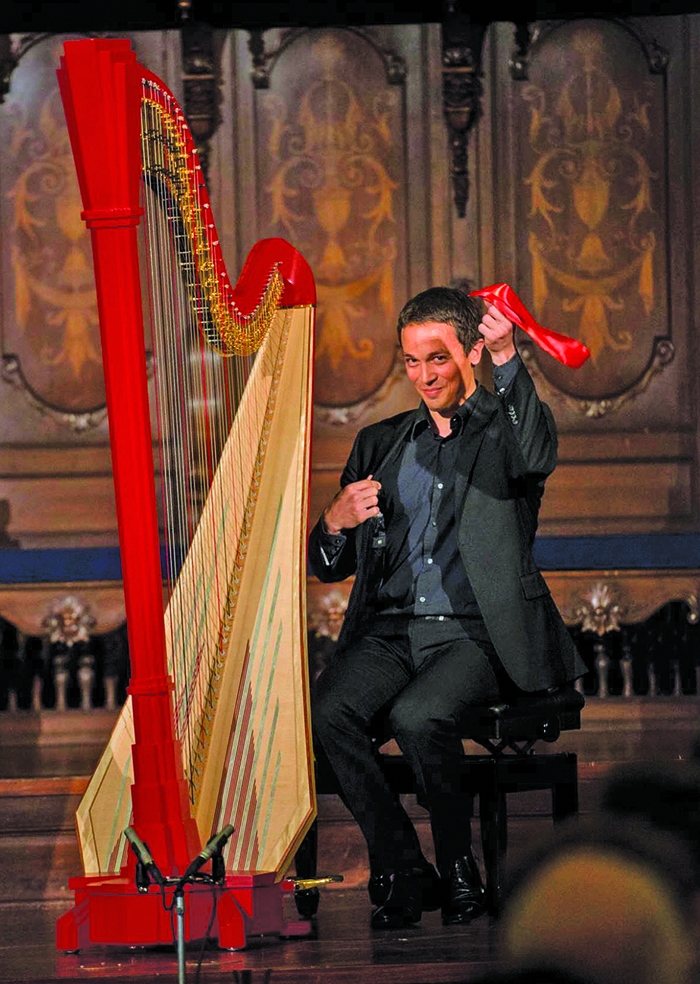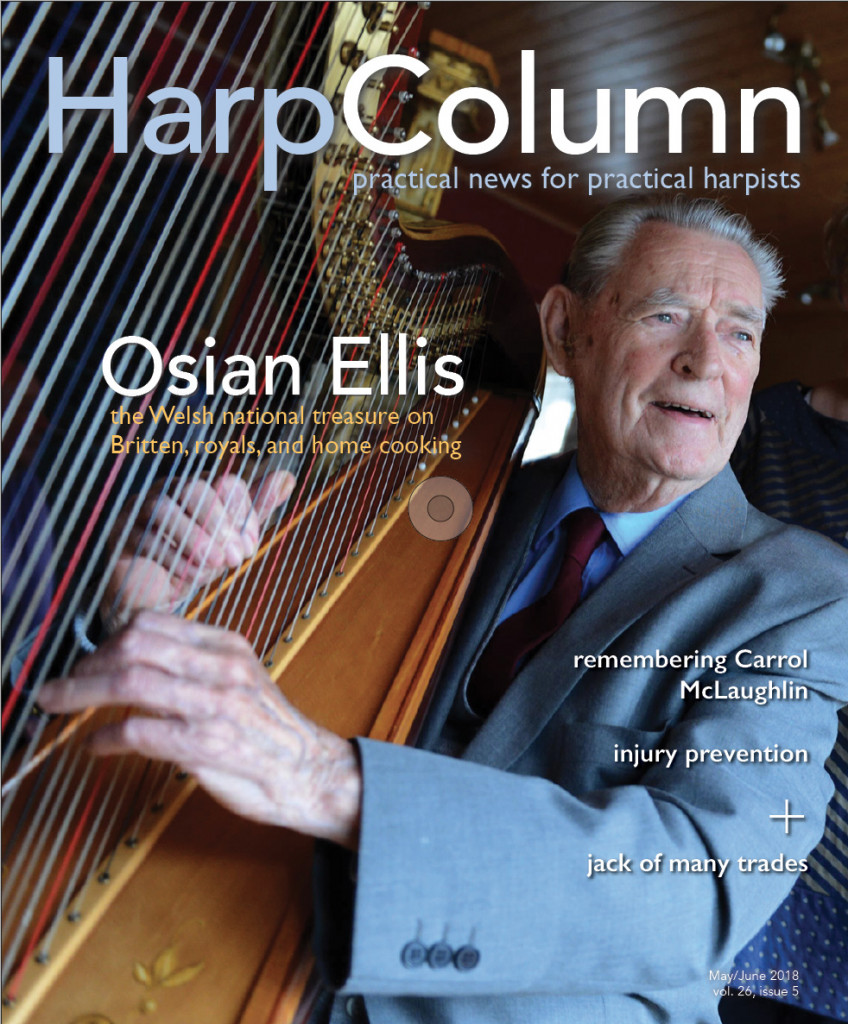Telling the story of Salzedo through music and color

First, there was the encounter. I will never forget that day in Chicago when I met the red Salzedo harp. It was during Lyon & Healy’s 150th anniversary celebration, and I first tried the special model at Lyon & Healy Hall. The visual impact it had on me was huge. I had been playing Salzedo models for around 10 years because I found their tone and projection qualities matched my approach of the harp. But in this bright and profound red finish, which still allowed the fragile veins of the wood underneath to be seen, it shocked me. I was even more astounded after laying my hands on it and playing the first chords of the Fauré Impromptu I always use to warm up—what a beautiful, deep, warm, and luscious sound it gave back to me. In an instant my decision was made. This harp was to be mine.
During red Salzedo’s first public appearance, it was clear that this harp had a similar visual impact on the audiences as it had on me. The crowd gasped as the harp was brought on stage, and it responded with enthusiasm as I introduced the harp as “my Carmencita” before playing my own paraphrase based on Bizet’s famous opera.
Speaking with the Lyon & Healy team after the concert that night, I was told the story behind the color. It was the exact shade of red Carlos Salzedo would use on his students’ scores. The harpmaker had deduced the hue by studying these old markings, which had been collected throughout the USA for the occasion. Building such a strong bond between Salzedo and his signature instrument was genius, and it got me thinking. This story had to be told in music, as a tribute to the man and the harp.
Before I could tell Salzedo’s story in music, I first had to write it in words. I gathered information about the man through books (Pentacle was a particularly great read,) and testimonials, trying to imagine what it would have felt like for this ambitious Basque man to travel to the USA in the early 20th century, to play at the Metropolitan Opera (the Met), to go back to France during World War I, and finally settle in America afterwards, where he would compose, teach, reinvent harp technique, perform and defend new music, and design instruments. He was more than just a harpist. Carlos Salzedo appeared to me to be a man of vision, a completely fulfilled artist whose work would influence generations of musicians to come. No wonder such a man would mark scores in red—no other color would do—potent, bold, and unforgiving is the color of our blood.
Next came the question of how to compile a repertoire that would serve the story of this man, but more broadly the story of how the harp existed through the ages and still thrives today as a striking and modern instrument that both enchants and bewilders audiences.
Of course, Salzedo’s work as a composer had to appear on the album, but not only his. To do the harp justice, I had to show how the instrument is approached by both harpists and non-harpists. To me, the work by Salzedo was an easy pick. There are few works that make me as happy and jubliant to play as Salzedo’s Ballade. It’s full of light, it’s electric, and it combines Impressionist charm with jazzy exuberance. So there you go, one piece picked, and a happy one at that.
I then focused on finding harp works displaying the instrument in an unconventional way—a way Salzedo would have found modern and interesting—and also relating to the color red.
I couldn’t pass up the obvious choice in this category—Caplet’s Conte Fantastique, based on Edgar Allen Poe’s short story “The Mask of Red Death.”
Second, on the same dark path, I chose the brilliant Ballade Fantastique by Henriette Renié, inspired by another of Poe’s stories “The Tell-Tale Heart.”
For my third choice in this genre, I took the recommendation of my Colombian friend Bibiana Ordonez Velandia, professor at the National University Conservatory of Bogota. She is interested in Latin American new music and suggested the Quinteto Rojo or Red Quintet, a dark work that is reminiscent of Caplet, by Argentinian composer Gustavo Leone.
Looking over the repertoire list now, it was clear that I must find a path to transition from the darkness of Renié, Caplet, and Leone, to the powerful light of Salzedo’s Ballade. Every album needs a dramatic evolution and a balance, so this one must be a journey from darkness to light!
Paul Hindemith’s Sonate, composed in exile just weeks after the outbreak of World War II, felt like a perfect link—I see it both as a work of sadness and hope. The poem introducing the third movement Lied also mentions a red ribbon hanging from a harp…I’ll take that as a sign.
And finally, as a beautiful conclusion to the album, what else than the gorgeous Debussy Danses, coinciding with the 100th anniversary of the composer’s death? I’m sure Salzedo must have played the Danses thousands of times while in the USA to defend European new music, one of his many fights.
Et voilà! I’m now in the steps of Salzedo myself, as principal harpist of the Met 100 years after him, playing red Salzedo harps both in the pit and on stage, and trying to be a good ambassador of the harp and the music, as he certainly was. And now, ladies and gentlemen, I give you Ballad in Red. •
Born and educated in France, Emmanuel Ceysson is principal harpist of the Metropolitan Opera Orchestra, a position he has held since 2015. Prior to that, Ceysson was principal harpist with the Paris Opera Orchestra. His new album Ballad in Red will be released in the United States on June 15.








